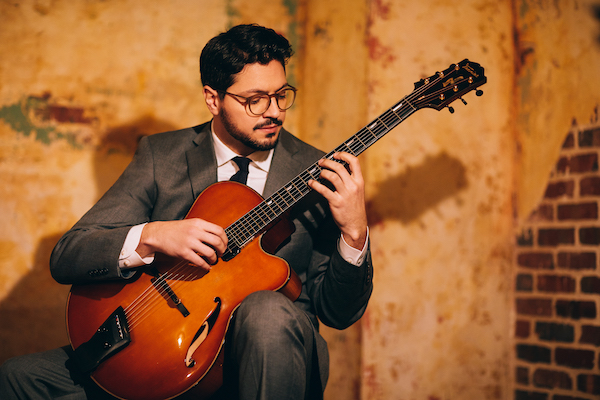Apr 2, 2024 12:59 PM
Saxophonist, Sonic Explorer Casey Benjamin Dies at 45
Casey Benjamin, the alto saxophonist, vocalist, keyboardist and producer who stamped his distinctive sounds on the…

Pasquale Grasso looks to address bebop pianism on guitar.
(Photo: Deneka Peniston)Growing up in Ariano Irpino, Italy, Pasquale Grasso regularly listened to foundational recordings of the bebop era. And by the age of 6, he was practicing guitar 12 hours a day.
Solo Standards, Vol. 1—Grasso’s Sony Masterworks debut—focuses on solo guitar, and finds the bandleader assimilating and extending the music’s zigzagging melodies and complex chords with elan. It seems as if all that practice paid off.
At a recent Sunday gig at New York’s Mezzrow, Grasso and his quintet blew a hurricane of bebop, ballads and standards. Utilizing classical guitar position and technique, Grasso—who took top honors at the 2015 Wes Montgomery Jazz Guitar Competition—essentially performed as a piano player, plucking chords with his right hand while fingering chords and solos on his left hand. (The fingers on his left hand are a half-inch longer than those on his right.) In any configuration, Grasso’s playing is practically faultless, his hands darting over the instrument like hummingbirds.
“I am always rooting for new players that come along, particularly folks who can answer questions of their own design that may not have been addressed before,” Pat Metheny, a mentor to the young guitarist, wrote in an email. “In Pasquale’s case, he set out on one of the most difficult treks imaginable on the instrument—a quest to deeply address the specifics of a post-war piano style that has eluded several generations of musicians. ... The depth of his vocabulary and stunning virtuosity on the instrument feels open-ended to me in the best possible way.”
Quiet and soft-spoken, the 30-year-old guitarist continues to practice up to six hours a day, even amid a schedule that’s included residencies at New York clubs like Django in TriBeCa and Tartina in Harlem.
“My goal was to play what I love, all the songs I grew up with,” Grasso explained at a West Village coffee shop. “Charlie Parker, Bud Powell and Art Tatum are my idols. I wanted to play like Bird, but it’s hard, because the guitar is such a weird instrument, especially for articulation and the sound and the fingering; there’s 10 ways of playing the same scale different.”
Sony Masterworks is matching Grasso’s dedication to bebop with a novel approach: Rather than release a single full-length album, the imprint’s releasing Grasso’s solo guitar work as three digital-only EPs: Solo Standards, Vol. 1 (currently available), Solo Ballads, Vol. 1 (currently available) and Solo Monk (Oct. 11), with the goal to popularize Grasso’s music in the world of streaming playlists and heavy headphone rotation.
“I wake up, and the first thing I want to do is practice,” Grasso said. “Today, I played some technique, some scales and arpeggios, then I played in different keys and played one song for 20 minutes. I spend my day for the music; I love doing this.” DB

Benjamin possessed a fluid, round sound on the alto saxophone, and he was often most recognizable by the layers of electronic effects that he put onto the instrument.
Apr 2, 2024 12:59 PM
Casey Benjamin, the alto saxophonist, vocalist, keyboardist and producer who stamped his distinctive sounds on the…

“He’s constructing intelligent musical sentences that connect seamlessly, which is the most important part of linear playing,” Charles McPherson said of alto saxophonist Sonny Red.
Feb 27, 2024 1:40 PM
“I might not have felt this way 30 to 40 years ago, but I’ve reached a point where I can hear value in what people…

Albert “Tootie” Heath (1935–2024) followed in the tradition of drummer Kenny Clarke, his idol.
Apr 5, 2024 10:28 AM
Albert “Tootie” Heath, a drummer of impeccable taste and time who was the youngest of three jazz-legend brothers…

“Both of us are quite grounded in the craft, the tradition and the harmonic sense,” Rosenwinkel said of his experience playing with Allen. “Yet I felt we shared something mystical as well.”
Mar 12, 2024 11:42 AM
“There are a few musicians you hear where, as somebody once said, the molecules in the room change. Geri was one of…

Henry Threadgill performs with Zooid at Big Ears in Knoxville, Tennessee.
Apr 9, 2024 11:30 AM
Big Ears, the annual four-day music celebration that first took place in 2009 in Knoxville, Tennessee, could well be…